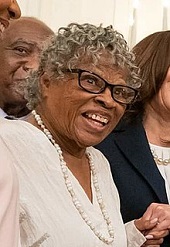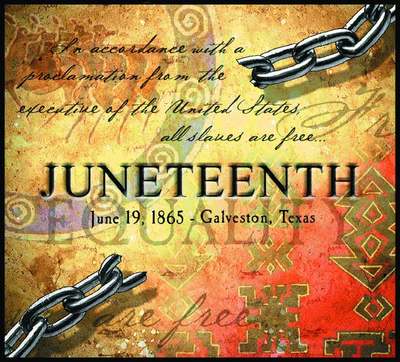On June 19 ("Juneteenth"), 1865, Union general Gordon Granger read the Emancipation Proclamation in Galveston, thus belatedly bringing about the freeing of 250,000 slaves in Texas. The tidings of freedom reached slaves gradually as individual plantation owners read the proclamation to their bondsmen over the months following the end of the war. The news elicited an array of personal celebrations, some of which have been described in The Slave Narratives of Texas (1974). The first broader celebrations of Juneteenth were used as political rallies and to teach freed African American about their voting rights. Within a short time, however, Juneteenth was marked by festivities throughout the state, some of which were organized by official Juneteenth committees. The day has been celebrated through formal thanksgiving ceremonies at which the hymn "Lift Every Voice" furnished the opening. In addition, public entertainment, picnics, and family reunions have often featured dramatic readings, pageants, parades, barbecues, and ball games. Blues festivals have also shaped the Juneteenth remembrance. In Limestone County, celebrants gather for a three-day reunion organized by the Nineteenth of June Organization. Some of the early emancipation festivities were relegated by city authorities to a town's outskirts; in time, however, black groups collected funds to purchase tracts of land for their celebrations, including Juneteenth. A common name for these sites was Emancipation Park. In Houston, for instance, a deed for a ten-acre site was signed in 1872, and in Austin the Travis County Emancipation Celebration Association acquired land for its Emancipation Park in the early 1900s; the Juneteenth event was later moved to Rosewood Park. In Limestone County the Nineteenth of June Association acquired thirty acres, which has since been reduced to twenty acres by the rising of Lake Mexia. Particular celebrations of Juneteenth have had unique beginnings or aspects. In the state capital Juneteenth was first celebrated in 1867 under the direction of the Freedmen's Bureau and became part of the calendar of public events by 1872. Juneteenth in Limestone County has gathered "thousands" to be with families and friends. At one time 30,000 blacks gathered at Booker T. Washington Park, known more popularly as Comanche Crossing, for the event. One of the most important parts of the Limestone celebration is the recollection of family history, both under slavery and since. Another of the state's memorable celebrations of Juneteenth occurred in Brenham, where large, racially mixed crowds witness the annual promenade through town. In Beeville, black, white, and brown residents have also joined together to commemorate the day with barbecue, picnics, and other festivities. Juneteenth declined in popularity in the early 1960s, when the civil-rights movement, with its push for integration, diminished interest in the event. In the 1970s African Americans' renewed interest in celebrating their cultural heritage led to the revitalization of the holiday throughout the state. At the end of the decade Representative Al Edwards, a Democrat from Houston, introduced a bill calling for Juneteenth to become a state holiday. The legislature passed the act in 1979, and Governor William P. Clements, Jr., signed it into law. The first state-sponsored Juneteenth celebration took place in 1980. Juneteenth has also had an impact outside the state. Black Texans who moved to Louisiana and Oklahoma have taken the celebration with them. In 1991 the Anacostia Museum of the Smithsonian Institution sponsored "Juneteenth '91, Freedom Revisited," featuring public speeches, African-American arts and crafts, and other cultural programs. There, as in Texas, the state of its origin, Juneteenth has provided the public the opportunity to recall the milestone in human rights the day represents for African Americans. BIBLIOGRAPHY: Randolph B. Campbell, "The End of Slavery in Texas: A Research Note," Southwestern Historical Quarterly 88 (July 1984). Doris Hollis Pemberton, Juneteenth at Comanche Crossing (Austin: Eakin Press, 1983). Vertical Files, Barker Texas History Center, University of Texas at Austin. William H. Wiggins, Jr., O Freedom! Afro-American Emancipation Celebrations (Knoxville: University of Tennessee Press, 1987). David A. Williams, The Emancipation Proclamation of 1863 and the Emancipation Proclamation, Texas Style (June 19, 1865) (Austin: Williams Independent Research Enterprises, 1979). Teresa Palomo Acosta Recommended citation: U.S. President Joe Biden on Thursday, June 17, 2021, signed into law an act designating June 19 as Juneteenth National Independence Day, making it a federal holiday.  Ms. Opal Lee worked for decades to make Juneteenth an official holiday after joining Tarrant County's Black Historical and Genealogical Society. She started with a walking campaign in cities along the route from her home in Ft. Worth, Texas to Washington D.C. She stopped at cities where she had been invited to speak and walk 2.5 miles to symbolize the 2.5 years it took for enslaved people in Texas to learn they were free. She has become known as the "Grandmother of Juneteenth". Her paternal great-grandmother had been born in bondage in Louisiana |
 History of Juneteenth Celebrations Susan Hawkins © 2024 If you find any of Grayson County TXGenWeb links inoperable, please send me a message. |